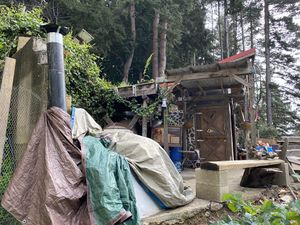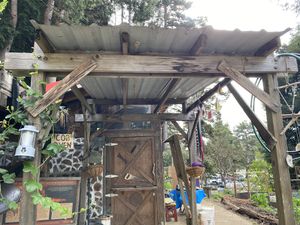

Background
This project will be taking place at Humboldt State University’s Campus Center for Appropriate Technology (CCAT) as part of the Appropriate Technology (ENGR 305) class in Spring 2020. Our team, Under One Roof, will be working with the center's three co-directors to retrofit the roof over the CCAT Earth Oven and the CCAT rocket mass cobb bench heater in their outdoor kitchen. As you can see in Fig. 1 and Fig. 2, the existing roof is made up of two parts. One is the living roof, which seems to have been made in 2006. Learn more about that project here. The other part of the roof does not seem to have an Appropedia page, but looks like it is made up of a wooden frame with corrugated metal sheeting. We have about 12 weeks to design, prototype, and complete this project, starting the first week of February 2020. Due to our geographical location, in the small town of Arcata on the coast of Northern California, we get a significant amount of rainfall and consistently high humidity. This has to be taken into account in the design of any project built here, outdoors or indoors. This is one of the reasons why the protection of existing projects is so important. Overall, the roof should be sturdy, functional, and aesthetic.
Problem statement
The roof currently in place is not successfully protecting the existing project in the outdoor kitchen. The objective of this project is to make a long-lasting and well-designed roof to protect the cobb oven and bench, as well as to provide a demonstration of green building and the potential of appropriate technology to teach future students and community members. The goal is to create incentive to make the outdoor kitchen at CCAT usable and enjoyable regardless of weather, to prevent weathering of the current projects in the outdoor kitchen, and to ensure that they last as long as possible in order to continue making an impact on future generations, and inspire the people that visit CCAT.
Our Team
- Under One Roof: Emily Read, Valentina Acosta, Nick Brandi, Buddy Mitchell
(add team photo here)
Literature Review
This is a review of the available literature pertinent to the a specific project.
Structure
Paragraph on the basics. [1]
AT Technology: Solar Energy, Rainwater Catchment System, Living Roof
Solar Energy: Solar Energy is the conversion of heat from the Sun to energy. Solar Energy is used today in many ways such as space heating and cooling, daylighting, hot water, and cooking. The most common way to harvest heat is solar panels.
Solar Energy Concerns: Main concern for using Solar Panels is location. Arcata, California is a cloudy and wet place throughout Fall and Spring. These panels will only be collecting optimal heat at very random times of the year and throughout the Summer months.
Types of Solar Energy:[2]
Type 1 Passive Solar Energy:[2] [3]
Passive Solar heating techniques involve placing larger windows on south-facing walls and locating thermal mass, such as a concrete slab floor or a heat absorbing wall, close to the windows. It collects energy during the day and then re-radiates it at night. Disadvantages: -Window installation -Thermal mass installation -Location and Climate Advantages: -Cost efficient -Natural approach -Environmentally friendly
Type 2 Active Solar Energy: [2] [3] Active solar energy systems use the same principles as passive systems except that they use a fluid (such as water) to absorb the heat. A solar collector positioned on the roofs of buildings heats the fluid and then pumps it through a system of pipes to heat the whole building. The two major types are solar hot water fluid collectors that heat a fluid circulated within them, and air collectors that heat air to be distributed in the house with fans. Disadvantages: -Location and climate -Cost efficiency -Roof condition Advantages: -Cost efficient in warmer temperatures -Environmentally friendly
Type 3 Photovoltaic (PV) Energy: [2] PV panels contain hundreds of small silicon cells that collect the sun’s energy and change it into electricity that can be used in a home or building, etc. PV cells are made mostly of silicon, an abundant semiconductor material (material that conducts current) in the earth’s crust. One side of the material is electrically positive, the other negative. When light strikes the positive side, the negative electrons are activated which then produce energy. Disadvantages: -Location and climate -Sunlight -Cost of Solar Panels Advantages: -Environmentally friendly -Solar Energy is infinite -Relatively cheap to create in rural areas, extends power grid
Designing interpretive materials[edit] According to ______ interpretive materials for composting should include....
Rainwater Catchment System: [4] Rainwater harvesting is a system that catches the water falling from the sky to use it for human use. It is usually categorized into two systems; passive and active. A passive type uses almost no mechanical means to capture, convey, or treat the caught rainwater. An active type uses mechanical and/or electrical means to capture, convey, and/or treat rainwater. This is a great way to raise water security in communities and localize water use.
Rainwater Catchment Concerns: Concerns for this system is storage, how big of a tank do we need and where we can put it. What this water will be used for such as potable water or non-potable water. Location of the system and if it will work in the area in which it is needed. Also what materials we can use for maximum safety of water use.
Types of Systems:
Passive System:[4] [5] This system uses landscape features to slow, absorb, and/or store rainwater. This type has the advantage of lower cost per volume of water. Advantages: -Low cost -Low impact -Natural approach Disadvantages: -Location/Vegetation -Maintenance
Active System: [6] This system uses mechanical and/or electrical means to capture, convey, and/or treat rainwater. Can be categorized into two systems; dry and wet. A dry system is one in which the conveyance system (e.g., downspouts) is evacuated and dry between rains, whereas a wet system is one in which the conveyance system remains filled with water between rains. Advantages: -Cleaner water Disadvantages: -Proper filtering and storage -Maintenance
Wet and Dry Systems: [4] Wet: A wet system has the advantage of being able to pipe the water underground and back up into a tank to keep the piping out of the way. Dry: A dry system has the advantage of less clogging and fewer insects.
Designing interpretive materials[edit] According to ______ interpretive materials for composting should include....
Living Roof: A living roof is a roof covered by a waterproofing membrane and then covered partially or completely by vegetation and growing mediums that retain water and transfer it back into the atmosphere through natural means. [7]
Concerns for Living Roof: The climate in which this roof will be built is not optimal for growing all types of vegetation.
Advantages: [7] -Maximizes use of space for gardening -Natural approach -Aesthetic -Potential to grow native species plants -Insulation -Air Quality
Disadvantages: [7] -Climate -Space
Designing interpretive materials[edit] According to ______ interpretive materials for composting should include....
References
Design
Prototyping
- ↑ This is an example of footnotes.
- ↑ 2.0 2.1 2.2 2.3 Johnston, David, and Kim Master. Green Remodeling: Changing the World One Room at a Time. Gabriola: New Society Publishers, 2005.
- ↑ 3.0 3.1 Spooner, Alecia M. “What Are Passive and Active Solar Energy Systems?” dummies.
- ↑ 4.0 4.1 4.2 Grafman, Lonny. To Catch the Rain: Inspiring Stories of Communities Coming Together to Catch Their Own Rain, and How You Can Do It Too.Arcata, CA: Humboldt State University Press, 2017.
- ↑ “Passive Water Harvesting.” Wahaso. Accessed February 16, 2020.
- ↑ “Active Water Harvesting.” Wahaso. Accessed February 16, 2020.
- ↑ 7.0 7.1 7.2 Francis, Robert A, and Jamie Lorimer. Urban Reconciliation Ecology: The Potential of Living Roofs and Walls. London, UK: Department of Geography, King's College London, 2011.